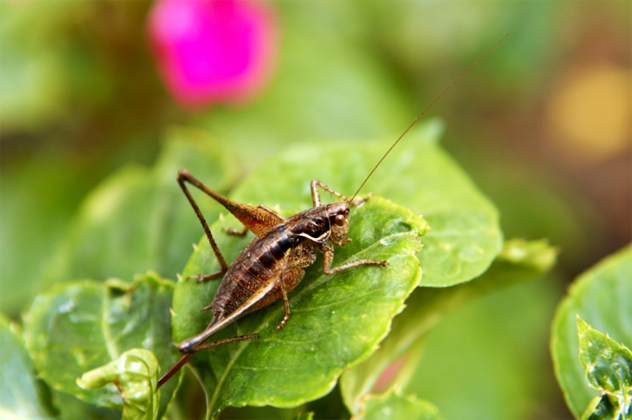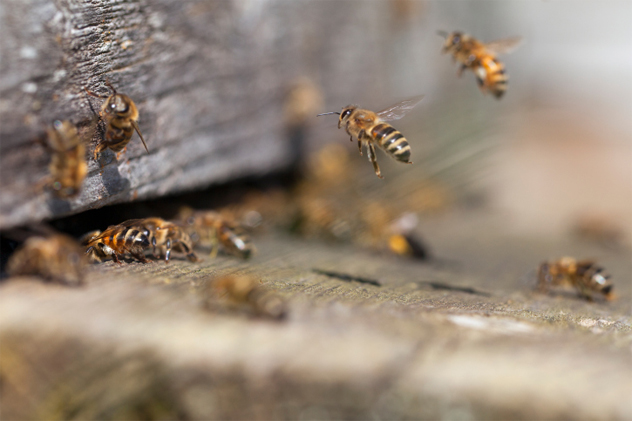 Miscellaneous
Miscellaneous  Miscellaneous
Miscellaneous  Our World
Our World 10 Green Practices That Actually Make a Difference
 Humans
Humans Ten Historic Men Who Deserve Way More Credit Than They Got
 Movies and TV
Movies and TV The 10 Most Heartwarming Moments in Pixar Films
 Travel
Travel Top 10 Religious Architectural Marvels
 Creepy
Creepy 10 Haunted Places in Alabama
 History
History Top 10 Tragic Facts about England’s 9 Days Queen
 Food
Food 10 Weird Foods Inspired by Your Favorite Movies
 Religion
Religion 10 Mind-Blowing Claims and Messages Hidden in the Bible Code
 Facts
Facts 10 Things You Never Knew about the History of Gambling
 Miscellaneous
Miscellaneous Ten Groundbreaking Tattoos with Fascinating Backstories
 Our World
Our World 10 Green Practices That Actually Make a Difference
 Humans
Humans Ten Historic Men Who Deserve Way More Credit Than They Got
Who's Behind Listverse?

Jamie Frater
Head Editor
Jamie founded Listverse due to an insatiable desire to share fascinating, obscure, and bizarre facts. He has been a guest speaker on numerous national radio and television stations and is a five time published author.
More About Us Movies and TV
Movies and TV The 10 Most Heartwarming Moments in Pixar Films
 Travel
Travel Top 10 Religious Architectural Marvels
 Creepy
Creepy 10 Haunted Places in Alabama
 History
History Top 10 Tragic Facts about England’s 9 Days Queen
 Food
Food 10 Weird Foods Inspired by Your Favorite Movies
 Religion
Religion 10 Mind-Blowing Claims and Messages Hidden in the Bible Code
 Facts
Facts 10 Things You Never Knew about the History of Gambling
10 Surprisingly Human Traits Found In Insects
It’s easy to think of insects as simple creatures that operate entirely on instinct. While it’s true that they’re simpler than vertebrates in many ways, we’re finding that they have a lot of traits that make them more like us than we’d have thought. You may know that ants farm, or that bees communicate via dance. Yet there are some less-expected ways that these little invertebrates, which represent up to 90 percent of multicellular life on Earth, are more like us than we realize.
10 Hitching A Ride

Riding on the back of another animal for getting around is something we’ve been good at for quite some time. Sitting yourself on another creature purely for transport is known as phoresy, and it’s pretty rare. Yet there are a lot of examples aside from humans on horseback. One unique case is that of a springtail riding a mayfly, since it’s only known from a 16 million-year-old amber specimen.
The tiny springtail had used its antennae to attach itself to the base of the mayfly’s wings for its journey. Unfortunately for the both of them, the mayfly picked an unwise resting spot and ended up encased in amber. The springtail may have tried to escape at the last moment—it was 50 micrometers (a 500th of an inch) away from its ride—but its efforts were in vain. Scientists think this probably still happens, but is just really hard to observe.
9 Weighing Priorities Based On Experience

When looking for a new home, there are a bunch of things humans take into account, like size, location, or the suspicious collection of skulls in the cellar. Yet certain things will appeal more than others based on our personal history—for example, if you’ve been stuck with seven people to a room in your old place, then a large number of bedrooms will matter more than good transport connections the next time you look for a house.
This ability to weigh up pros and cons based on experience has also been found in ants. When choosing a place to live, the ant species Temnothorax rugatulus likes a small entrance and not much light. If they spend some time in an environment where all the entrances to potential nests are the same size but light levels differ, they’ll pick the darkest.
If those ants are then given a selection of sites with a mixture of entrance sizes and lighting levels, they’ll continue to prioritize light levels. Ants put in the opposite situation continue to prefer a small entry hole. The scientists that did the experiment remained unsure on one point. Study author Stephen Pratt said “You have hundreds of these ants, and somehow they have to reach a consensus. How do they do it without anyone in charge to tell them what to do?” That’s a question he hopes to be able to answer with further research.
8 Dragonflies Have Selective Attention

Human brains are awesome; those of Listverse readers doubly so. Even so, there’s only so much information we can process at any given time. We have a limited amount of attention available, so we can either focus intently on a single task, or give a little bit of attention to a bunch of different stuff. Our brains are able to shut out unnecessary information, a trait only demonstrated in primates—and now also dragonflies.
Scientists put sensors in a dragonfly’s brain (the sensors were 1,500 times thinner than a human hair) and monitored activity while it hunted prey. If there was more than one target available, the dragonfly’s brain picked one and then acted as if the other targets didn’t exist. This neural filtering allows the creatures to hit their mark 97 percent of the time. Given that dragonflies often hunt in swarms of prey, this is a useful feature. This unexpected discovery is significant to our understanding of neuroscience, but could also help us develop vision for intelligent robots.
7 Bees Can Understand Abstract Concepts And Do Math

Bees and humans both enjoy picnics, although bees are rarely the ones to actually bring sandwiches. Aside from our shared love of al fresco dining, bees also share the defining trait of higher thought—in other words, they’re able to process abstract concepts. Scientists set up two places for bees to land, one of which had a drop of sugar water (yum) and the other a drop of quinine (yuck). These were stuck on a wall, and two distinct images were placed either on each side of a landing spot, or above and below.
After a bunch of tries, the bees were able to figure out which orientation led to the sugar water and chose it consistently. The scientists then changed the pictures, but kept the relative positions the same. The bees were still able to go straight to the correct option no matter what images were used, showing that relative position was a concept they could get their heads around.
Bees are also able to solve the complex mathematical task of plotting the shortest route between a bunch of flowers. This is famously known as the Travelling Salesman Problem and it can keep our best supercomputers busy for hours or days. Understanding how bees manage to do it with their tiny brains offers the potential for improving how we build artificial intelligence.
6 Chivalry In Crickets

Observations of wild crickets have found that when a male and a female pair are together, the male actually displays chivalry. Scientists found that if the crickets were to come under attack from a predator, the male waited until the female was safely inside a burrow before climbing in himself. Predictably, this increased his chances of being caught and eaten, though it was good news for her.
As you might expect, there’s an ulterior motive to all this self-sacrifice. Cricket reproduction involves the male implanting a small package (called a spermatophore) into females that continues to inject her with sperm, but the females can remove it if they wish. Females that experience chivalry leave the spermatophore in place longer than those that don’t. These observations paint male crickets in a kinder light than previous lab experiments. Scientists used to believe male crickets used coercion to stop the female from removing the spermatophore, but it turns out they’re nothing but gentlemen.
5 Bees Get Stressed

When you’re feeling stressed, it’s extremely easy to take a pretty dire attitude towards the future. People are much more likely to see their glass as half full when they’re happy (though it’s hard to predict what their mood will be once they’ve finished the glass). Now, scientists have found the same thing in bees.
A large group of bees were given a choice of two liquids containing either sugar or quinine. Each liquid also contained a mixture of odors. The liquid with the sweet, tasty sucrose was mixed with one part hexanol and nine parts octanone to give it a smell bees could recognize. The quinine liquid had the odorants in opposite proportions.
Once the bees learned to go for the mostly octanone mixture, scientists took half the poor critters and stuck them in a machine designed for vigorously mixing chemicals. This shook them violently for a minute, mimicking a badger attack on a hive. Bees of both the shaken and unshaken groups were then exposed to mixtures scented with differing proportions of octanone and hexanol.
They continued to go for mixtures with more octanone, as expected. But when given a mixture that was exactly half of each, the shaken bees were much more hesitant to try it out. Like the unshaken bees, they realized that there was a possibility of sugar, but they weren’t exactly having much luck, so why risk it? This display of distrust suggests a higher level of feeling than we give bees credit for.
4 Bees React The Same To Cocaine

It’s not just stress that demonstrates surprising parallels between bees and humans. Scientists from Macquarie University in Sydney decided to give cocaine to a group of bees and see what happened (we’re not sure if this was an actual experiment or just a faculty party that got out of hand). They then compared the bees’ dancing to that of their sober brethren and found that the drug affected them pretty much the same way it affects people.
The coked-up bees danced more often and more vigorously when they got back from pollen hunting. Some bees were put on the drug for a week and then taken off it. When they were given a learning test they failed miserably, suggesting that they had become addicted and were going through withdrawal. Looking at the neural and genetic changes in these bees could possibly help scientists figure out how to treat cocaine addiction in humans.
3 Crickets Learn To Show Off

That whole “crickets are gentlemen” thing extends to the old-fashioned notion of settling every disagreement with a duel. Crickets are notoriously aggressive towards one another, making cricket fighting a popular sport in China. It’s pretty much what it sounds like—people keep crickets as pets, then square them off against the crickets of other competitors. Champion crickets can sell for upwards of $1,500, and over $150,000 can be bet on a single match.
Yet dozens of eager people gathered around with baited breath doesn’t make much of a difference to crickets. They do, however, love to show off if other crickets are watching. Scientists found that crickets fought harder if they knew they were under observation by members of their own species—male or female. They also performed a more jubilant victory dance afterwards.
The reasons for the display are similar to what we’d expect from human men in a fight. Lady crickets tend to prefer the strong, dominant type, so it’s good for their chances of mating. It also lets the other males know who’s not to be messed with. The reaction was more pronounced in wild crickets, showing that the aggression is in part a learned social behavior. This capacity for adaptive memory is actually what surprised the researchers the most.
2 Cockroaches Groom Themselves

The mere thought of cockroaches is enough to trigger disgust. In pop culture they’re a shorthand for poverty, and they’re notoriously difficult to get rid of. It’s not easy to be less popular than both spiders and rats, but these stinking, filthy disease-carriers manage it. But despite the stereotypes, cockroaches actually make an effort to clean themselves, or at least their antennae.
Cockroaches pull their antennae into their mouths with their forelegs to remove debris. Researchers from North Carolina State University prevented a group of roaches from doing this, and found that it led to a buildup of waxy secretions. Predictably, this had a negative impact on the roaches’ ability to sniff out pheromones and other odors. So it seems humans and cockroaches both clean themselves so they smell better, though in a very different sense of the word.
1 Ants Have Teachers

Animals are known to copy each other to learn how to behave. Yet teaching is slightly different than copying. Scientists looking at animals define teaching as an animal going specifically out of its way, with a cost of time or energy, to help another individual learn. British researchers observed this behavior in ants, and claim that it’s the first example of formal teaching ever witnessed in animals that aren’t humans.
The behavior they looked at is called tandem running, and involves one ant teaching another the route to a source of food. The teacher runs ahead while the pupil follows, but the pupil will sometimes have to stop to get its bearings. The teacher will wait until its follower wants to move on—the learner actually taps the lead ant to signal when it’s ready to continue. This whole process means it takes the teacher four times longer to reach a food source, but makes getting there much quicker for the ant receiving the help.
Alan hopes that ants and bees never form an alliance and attack because we’d never have a chance.








